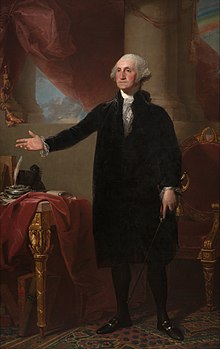
Beginning with painter Gilbert Stuart's portrait of George Washington, it has been tradition for the president of the United States to have an official portrait taken during their time in office, most commonly an oil painting. This tradition has continued to modern times, although since the adoption of photography as a widely used and reliable technology, the official portrait may also be a photograph (or at least a photograph may be viable[1]).
Presidents will often display the official portraits of former presidents whom they admire in the Oval Office or elsewhere around the White House, loaned from the National Portrait Gallery. The gallery has collected presidential portraits since its creation in 1962, and began commissioning their portraits in 1994, starting with George H. W. Bush.[2]
In 2018, President Donald Trump signed Public Law 115–158, which prohibits the use of federal funds to pay for an official portrait of any federal official or officer, including the president, the vice president, a member of Congress, the head of an executive agency, or the head of an office of the legislative branch. As most recent presidential portraits have been privately funded, this law primarily prevents other governmental officers such as agency heads and speakers of the House from commissioning official portraits using federal funds.[3][4]
- ^ Heil, Emily. "Don't look for Obama's official portrait anytime soon". Washington Post.
- ^ "Fact Sheet: "America's Presidents" | National Portrait Gallery". Npg.si.edu. Retrieved July 22, 2022.
- ^ Bill, Cassidy (March 27, 2018). "S.188 - 115th Congress (2017-2018): Eliminating Government-funded Oil-painting Act". www.congress.gov. Retrieved April 4, 2018.
- ^ "Trump signs bill barring federal funds to pay for official portraits". Politico. Retrieved April 4, 2018.